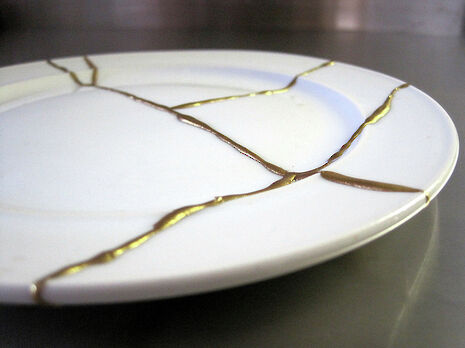A plate of poetry, please: The concept of cracks
Jade Cuttle looks at perfect imperfections

“There is a crack in everything. That's how the light gets in." Leonard Cohen, Selected Poems, 1956-1968
The concept of cracks may seem a strange subject for contemplation, but these overlooked creatures of absence are sometimes the constructive features that frame our existence. Are you a constellation of cracks inside? It is possible that we are not quite human without our flaws.
A crack is more often than not covered-up, fixed and filled; the same for scuffs and scratches, smoothed out of sight into oblivion. But some cracks can be constructive, a space to fill. If one can see beauty within their deep and dark abyss then this will project a positive light upon the self and upon any damage that one may deal with inside. The trace of damage is not necessarily defeat. What we perceive to be bitter failure and flaws may actually be where brilliance or beauty is born.
This analogy is most readily applied when taken from an amorous perspective. The façade falsity eventually cracks in figurative collapse, a haunting absence. It cracks into memories of a broken heart, experience always shaping expectations, a missed opportunity, lost loved one, or long held regret. My existence has been governed by giant cracks, sometimes opening up so wide that I feel I will be swallowed. There has not been a single day when my heart has forgotten the wounds of its first love. Even now I think I catch a glimpse in a crowd of the same jumper and haircut and wonder how conversation would patch the gap. I used to curse the captivating force of memory that haunts the human heart, until realising very slowly that the uncomfortable vacuum and unwelcome void has been responsible for many great things. It has now become a source of gratitude.
The Japanese art of kintsugi accepts this philosophy in the most poignant way. In repairing broken pottery with powdered gold, the piece is perceived as more beautiful, precisely for having been broken. The process is based on the perception that breakage is part of the valued history of an object rather than something to simply disguise. Its aesthetic is centred on the acceptance of transience and imperfection, valuing asymmetry and asperity, roughness and lack of regularity. Such irregularity inspires intrigue. I have always found such fissures to be fascinating: the wound left upon the window when the stone is tossed, its glass shivering and shaking in unique and unreproducible patterns. The cracks in a canvas are sometimes more suggestively impressive than the artwork itself. If we adopt the poetic kintsugi perspective, even if briefly, then just imagine the calm, confidence, and contentment that would descend upon our souls. The fear of falling prey to the clutches of time with greying hair and wrinkles would no longer hold us hostage, nor would many of the falsely-mediatised ideals of beauty and perfection.
Such ideals are not constrained to aesthetic considerations. To elucidate this point, we might dwell upon a proverb of a woman collecting water from a stream in two pots hung on a pole across her neck. While the first pot is perfect in delivering its full portion of water and proud of its accomplishments, the poor cracked pot leaks and is ashamed of its imperfections. It is miserable in managing only half of its purpose. The wise old woman has always known about the flaw and accepts it in favour of the flowers it nurtures: “I planted flower seeds on your side of the path and every day while we walk back, you water them. I have been able to pick these beautiful flowers to decorate the table. Without your cracks there would not be this beauty to grace the house.” There are flowers only where the water leaks.
If there is any poetry to be found in a cracked bone or tooth, admittedly it would be obscured by pain: poetry can't be beautiful all the time. But it can be practical. It is possible that substance is sometimes held together by absence: a person existing not in spite of but because of the absence they cling onto. Let us take long distance relationships: the promise of the absence being filled is a fuelling force, until we see them again at the end of term.
If absence does not necessarily hold substance together, then it plays at least a significant role in its structure. A fishing net without holes is not very helpful for catching fish, as with a spider's web or sieve: their material presence needs absence to be fully functional. The same can be said of the creatives. Listen to the sad songs and the heartbreak needed to produce such talent.
 News / Caius mourns its tree-mendous loss23 December 2025
News / Caius mourns its tree-mendous loss23 December 2025 News / Clare Hall spent over £500k opposing busway 24 December 2025
News / Clare Hall spent over £500k opposing busway 24 December 2025 Comment / Yes, I’m brown – but I have more important things to say22 December 2025
Comment / Yes, I’m brown – but I have more important things to say22 December 2025 Comment / The ‘class’ of Cambridge24 December 2025
Comment / The ‘class’ of Cambridge24 December 2025 Interviews / Politics, your own way: Tilly Middlehurst on speaking out21 December 2025
Interviews / Politics, your own way: Tilly Middlehurst on speaking out21 December 2025







